Tribunal Statistics Quarterly, July to September 2020
Published 10 December 2020
1. Main Points
This publication gives tribunal statistics for the latest quarter (July to September 2020, Q2 2020/21), compared to the same quarter the previous year. This quarter’s publication does not include Social Security and Child Support (SSCS) data due to issues identified when this tribunal was migrated to a new operational system. The data will be made available as soon as this is resolved and the data quality assured. This bulletin will focus on all the other individual tribunals and not the overall picture as the excluded tribunal forms a large proportion of the overall caseload.
For technical detail about data sources, quality, policy changes and terminology, please refer to the accompanying Guide to Tribunal Statistics.
| Single ET claims received continued to rise following the abolition of ET fees The trend in multiple claims is volatile |
Single Employment Tribunal (ET) receipts and caseload outstanding increased, by 13% and 22% respectively, compared to a year ago. Disposals decreased by 7%. Multiple ET receipts and caseload outstanding increased by 24% and 11% respectively, over the same period, while disposals decreased, by 61%. |
| FTTIAC receipts and disposals decreased while caseload outstanding increased | First-Tier Tribunal Immigration and Asylum Chamber (FTTIAC) receipts and disposals fell (by 50% and 81% respectively) compared to the same period in 2019. Caseload outstanding rose, by 9%, over the same period. |
| SEN appeals and disposals up 13% and 14% respectively | In the academic year 2019/20 HMCTS tribunals recorded 7,900 registered appeals in relation to SEN, an increase of 13% when compared to the prior year. In the same period, 6,700 SEN appeals were disposed of, an increase of 14% on 2018/19. |
For feedback related to the content of this publication, please contact us at CAJS@justice.gov.uk
2. Statistician’s Comment
Trends in Tribunals receipts and appeals continue to be driven by the wider impact of Covid-19 and measures put in place by the different jurisdictions. While there has been a fall in receipts and disposals across some jurisdictions, there have also been increases in others.
The combination of the impact of Covid-19 on the economy and unique challenges on court resources has led to the highest level of Single ET claims since 2013/14, alongside an increase in the outstanding caseload. This rise in Employment receipts is likely to continue as the economy has faced a severe shock following the impact of Covid-19 and could be further accelerated when the furlough scheme ends.
The decision taken by Government to extend some visa and asylum rules in response to the pandemic, led to a considerable fall in Immigration and Asylum receipts and disposals. We expect to see a rise in cases now the guidance has ended and the Home Office start making decisions on visa applications again.
Restrictions put in place due to Covid-19 have meant lower sittings and reduced disposal rates leading to an increase in the backlog of cases. To support access to justice, audio and video technology capability has been increased, enabling judges to conduct remote hearings to a far greater degree. Mental Health and Special Educational Needs and Disability disposals increased as remote hearings have been utilised to progress the caseload in some circumstances.
3. Employment Tribunals
Employment tribunal single cases
In July to September 2020, single claim receipts increased by 13%, while disposals decreased by 7%, when compared to the same period in 2019. Outstanding caseload rose by 22%. Mean age at disposal was 39 weeks, five weeks more than in July to September 2019.
Employment tribunal multiple cases
Receipts rose, by 24%, this quarter when compared to the same period in 2019. Disposals fell, by 61%, over the same period, while caseload outstanding increased by 11%. Mean age at disposal fell from 112 weeks to 95 weeks over the same period.
Figure 3.1: Index of Employment Tribunals single and multiple claim receipts, Q1 2009/10 – Q2 2020/21 (Source: Tables S_2)

* Baseline 2009/10 Q1
Figure 3.2: Index of Employment Tribunals single and multiple claim disposals, Q1 2009/10 – Q2 2020/21 (Source: Tables S_3)[footnote 1]
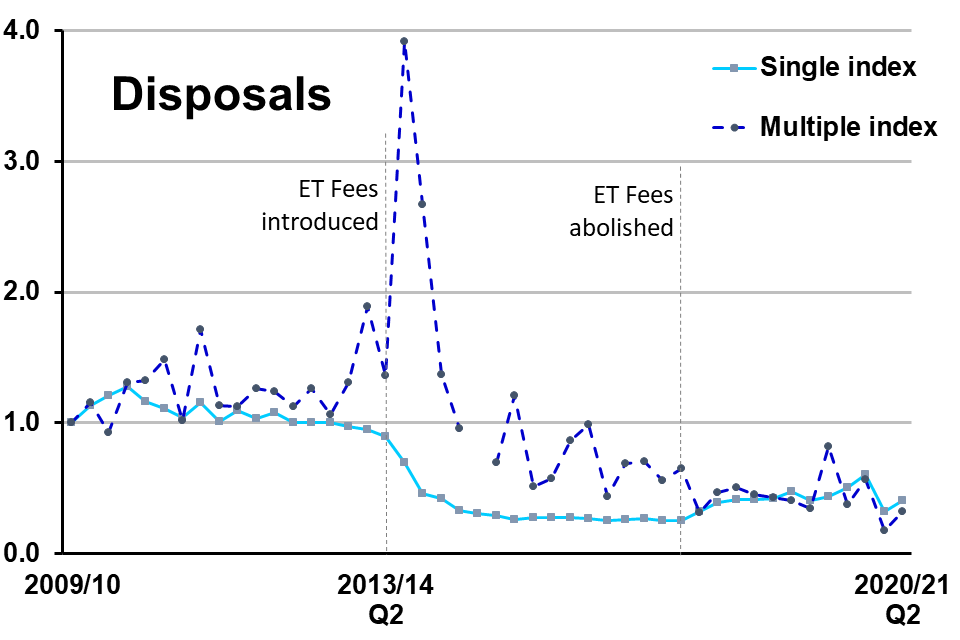
* Baseline 2009/10 Q1
Figure 3.3: Index of Employment Tribunals single and multiple claims outstanding, Q1 2009/10 – Q2 2020/21 (Source: Tables S_4)

* Baseline 2009/10 Q1
The number of single claim receipts has increased by 13% to 11,000 in the current quarter, when compared to the same period in 2019, most likely due to the rise in unemployment and changes to working conditions seen during the COVID-19 pandemic. Caseload outstanding (at 40,000) continues to rise having passed the peak levels seen in 2009/10 (when it was 36,000 in Q2 of that year) in the first quarter of the 2020/21 financial year, driven by the increase seen in single claim receipts and the reduction in disposals.
There were 19,000 multiple claims received this quarter, up 24% on the same period last year. Multiple claims tend to be more volatile as they can be skewed by a high number of claims against a single employer. The multiple claims received this quarter related to 930 multiple claim cases (averaging 18 claims per multiple case). This is up from 660 multiple cases in the same period a year ago, which had an average of 17 claims per case.
The Employment Tribunal disposed of 9,200 claims during July to September 2020, down 39% on the same period in 2019. This decline in disposals is likely due to COVID-19 related impacts on the tribunals. This was due to a 7% and 61% decrease in single and multiple claim disposals (to 5,700 and 3,400) respectively. The multiple claims disposed of relate to 410 multiple cases, down from 450 cases in July to September 2019.
In July to September 2020, 29% of disposals were withdrawn (the most common outcome this quarter), 22% were ACAS[footnote 2] conciliated settlements, 18% were dismissed upon withdrawal, 10% were struck out (not at a hearing) and 7% were successful at hearing. The most common jurisdictional complaint disposed of between July to September 2020 was ‘Unauthorised Deductions’, this was also the most common complaint in July to September 2019.
Employment Tribunal Fee (ET) Refunds
From the launch of the ET fee refund scheme in October 2017 to 30 September 2020, there were 22,000 applications for refunds received and 23,000 refund payments made, with a total monetary value of £18.3 million.
Between 1 July 2020 and 30 September 2020, 39 refund applications were received (up from 15 in Q1 2020/21) and 68 refund payments[footnote 3] were made with a total value of £179,000.
The ET fee refund scheme[footnote 4] was introduced as a phased implementation scheme in October 2017 following the abolition of ET fees on 26 July 2017. Since the introduction of the scheme, a total of 22,000 applications for refunds have been received and 23,000 payments have been made, with a total value of £18,335,000 as at 30 September 2020.
The cumulative number of payments is higher than the number of applications because the applications figure is still provisional. Online applications that are processed without manual input are not included in these figures. The number of applications will be updated in a later publication.
Of the applications received between July to September 2020, 54% (21 applications) related to cases initially brought in England and Wales, down from 87% in the quarter to 30 June 2020. The remaining 46% of applications received this quarter (18 applications) related to cases initially brought in Scotland.
In the quarter July to September 2020, 68 refund payments were made by the MoJ, with a total monetary value of £179,000. Of these:
-
75% (51 refunds) related to England and Wales, 25% (17 refunds) to Scotland.
-
94% (64 refunds) related to single claims, 4% (three refunds) related to multiple claims. As each refund payment may relate to several fees paid by the claimant for several cases, 1% (one refund) relate to both single and multiple claims.
Figure 3.4: Employment Tribunal fees – refund applications received, Q3 2017/18 – Q2 2020/21 (Source: Tables ETFR_1)
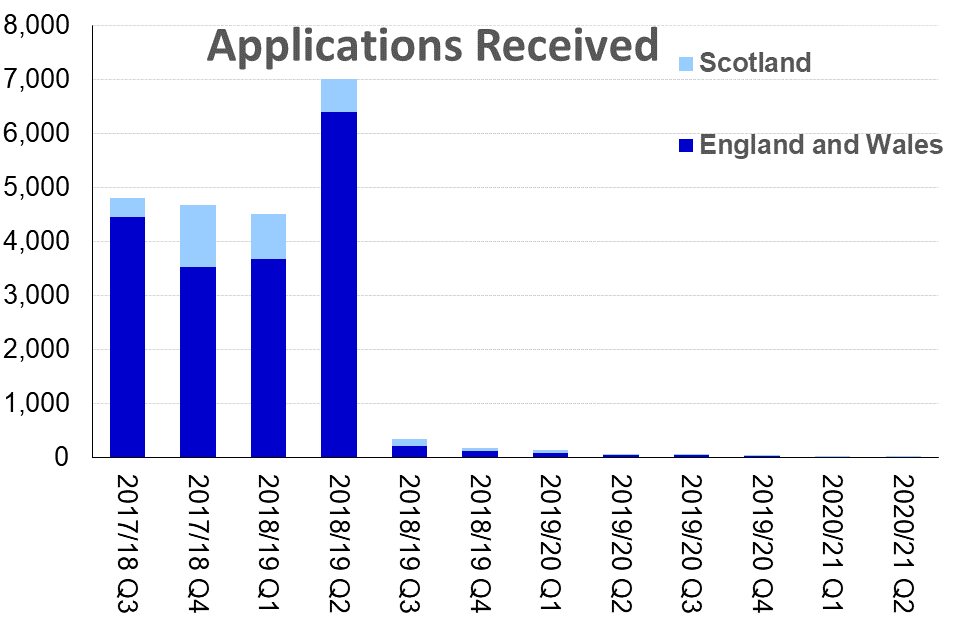
Figure 3.5: Employment Tribunal fees – refund applications processed, Q3 2017/18 – Q2 2020/21 (Source: Tables ETFR_1)
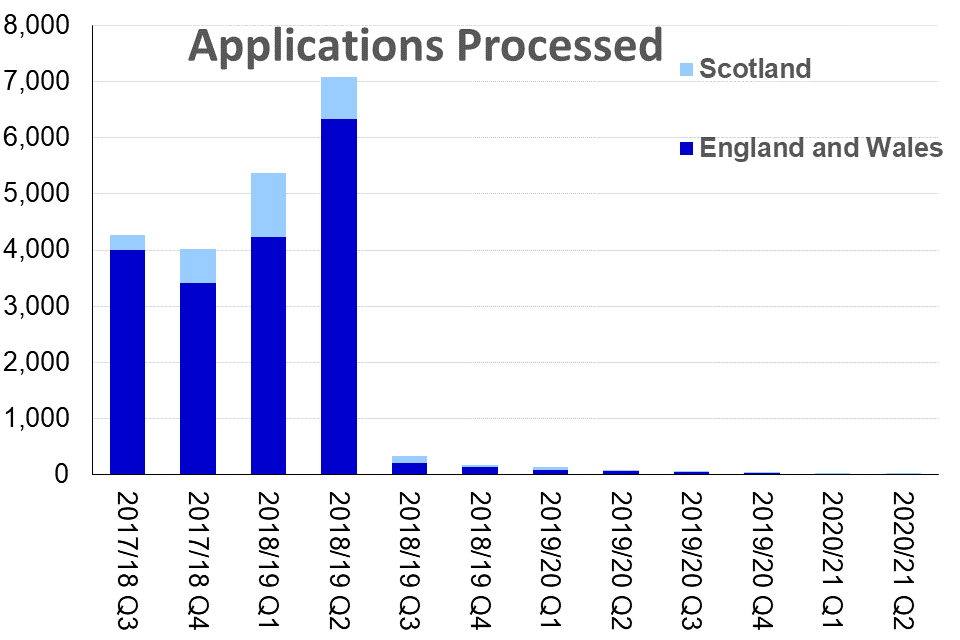
Figure 3.6: Employment Tribunal fees – refund payments made, Q3 2017/18 – Q2 2020/21 (Source: Tables ETFR_2)
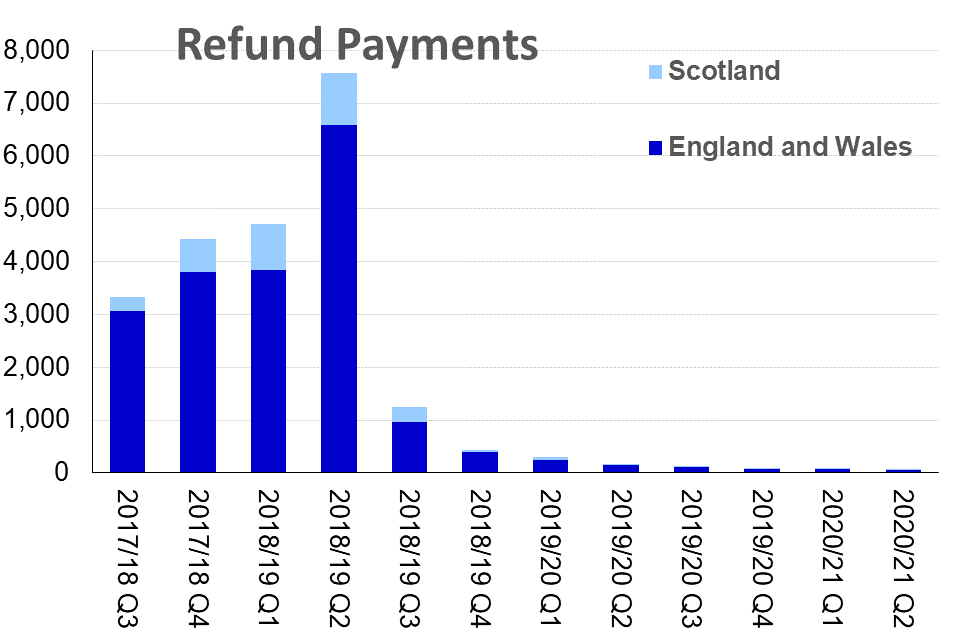
The large drop seen between Q2 and Q3 2018/19 follows the mailshot campaign which ended in July 2018 and resulted in exceptionally high receipts initially, particularly in England and Wales.
Due to the low volumes of ET fee refund applications and payments, these figures will be reported annually after this financial year.
4. Immigration and Asylum
First-tier Tribunal Immigration and Asylum Chamber (FTTIAC)
In July to September 2020, FTTIAC receipts and disposals decreased, by 50% and 81% (to 5,300 and 2,600) respectively, compared to the same period in 2019.
In the same period, caseload outstanding increased by 9% (to 22,000), ending the downward trend seen since the peak in April to June 2016.
Figure 4.1: First-tier Tribunal Immigration and Asylum Chamber receipts, Q2 2018/19 to Q2 2020/21 (Source: Tables FIA_1)
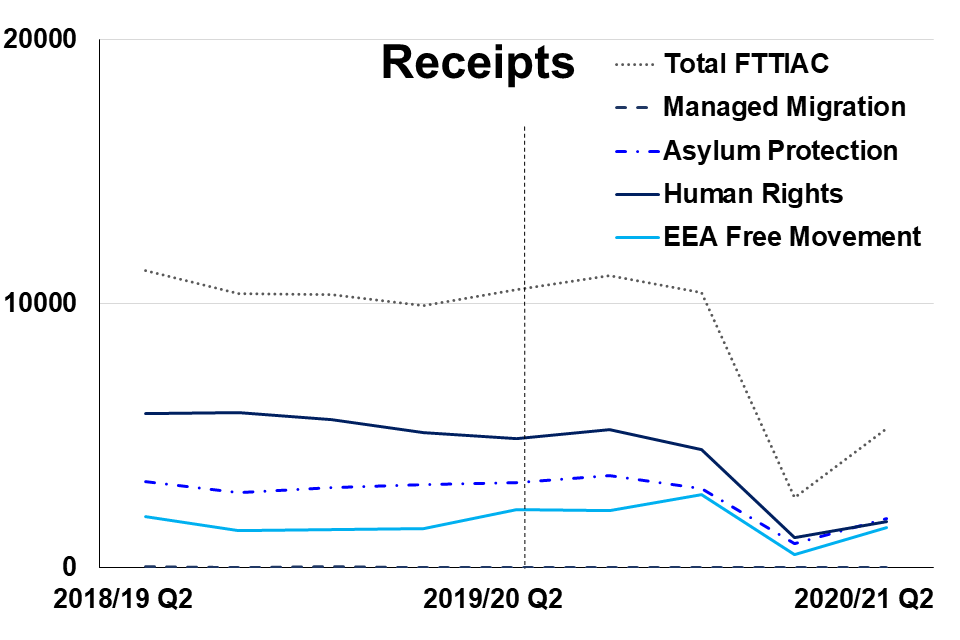
Figure 4.2: First-tier Tribunal Immigration and Asylum Chamber disposals, Q2 2018/19 to Q2 2020/21 (Source: Tables FIA_2)
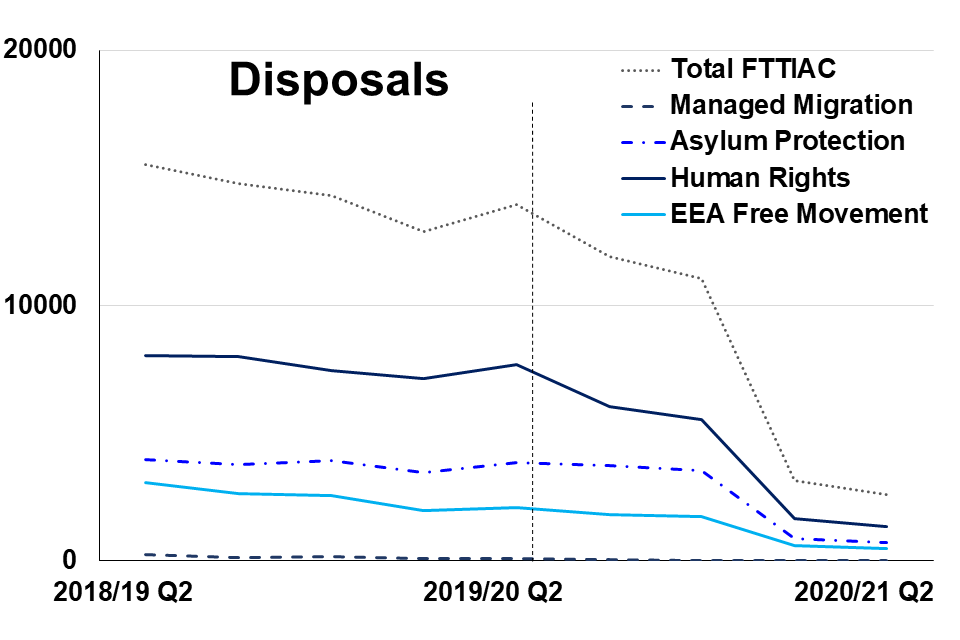
Figure 4.3: First-tier Tribunal Immigration and Asylum Chamber caseload outstanding, Q2 2018/19 to Q2 2020/21 (Source: Tables S_4)

In July to September 2020, Asylum/Protection (AP) receipts proportionally represented 35% of all FTTIAC receipts (up from 31% a year ago). In Q2 2020/21 there was a 64%, 43% and 30% decrease in Human Rights (HR), AP and EEA Free Movement receipts respectively (to 1,700, 1,800 and 1,500 respectively), compared to the same period in 2019. HR and EEA proportionally represented 33% and 29% of all FTTIAC receipts respectively (down 14 percentage point and up eight percentage points respectively from a year ago).
Low volumes seen in FTTIAC are likely due to measures put in place by the Home Office in response to coronavirus. These include: extending visas until 31st July 2020 due to travel restrictions or self-isolation related to coronavirus; switching to long-term visas; extending visas for NHS workers; relaxing conditions for Tier 1 entrepreneur visas and sponsors duties; cancellation of face-to-face substantive asylum interviews and allowing further submissions for a new claim by post or email; and allowing asylum seekers and refugees to remain in government accommodation until end of June 2020. Now that the Home Office has started issuing visas again and EU exit negotiations conclude, demand is likely to increase.
The FTTIAC disposed of 2,600 appeals in July to September 2020, an 81% decrease on the same period in 2019. This fall was driven by an 81%, 83% and 76% fall in AP, HR and EEA respectively. Human Rights appeals continue to make up the largest proportion (51%) of all FTTIAC disposals in July to September 2020, down from 55% a year ago.
Of the disposals made in the FTTIAC this quarter, 46% were determined i.e. a decision was made by a judge at a hearing or on the papers; 44% were withdrawn; 4% were struck out for non-payment of the appeal fee, and 3% were invalid or out of time. Just under half (48%) of the 1,200 cases determined at a hearing or on the papers were allowed/granted, although this varied by case type (47% of Asylum/Protection, 50% of Human Rights and 44% of EEA Free Movement appeals were allowed/granted).
In the FTTIAC, the mean time taken to clear appeals across all categories has increased by five weeks to 39 weeks this quarter compared to the same period a year ago. Asylum/Protection, Human Rights and EEA Free Movement had mean times taken of 40 weeks, 39 weeks and 36 weeks respectively. Managed Migration, which had a mean time taken of 222 weeks, is an older appeal category, removed by the Immigration Act 2014. There are a small number of remaining appeals which have longer clearance times due to the circumstances of those individual appeals.
Upper Tribunal Immigration and Asylum Chamber (UTIAC)
In July to September 2020, UTIAC receipts and disposals decreased, by 36% and 63% respectively, when compared to the same period in 2019, while caseload outstanding rose 80%.
UTIAC judicial review receipts continue to fall - down 75%, to 380. Disposals and caseload outstanding also fell by 52% and 72%, to 990 and 660 respectively, compared to July to September 2019.
At the UTIAC, there were 740 appeal receipts in July to September 2020, down 36% on the same period in 2019. AP and HR receipts drove the decrease in receipts, falling 51% and 24% to 250 and 400 appeals respectively. EEA increased by 1% to 69 appeals.
Over the same period, UTIAC disposals decreased 63% to 550. UTIAC disposals had previously been falling in each quarter from Q4 2018/19 to Q1 2020/21 (see table UIA_2).
At the end of September 2020, the UTIAC caseload outstanding stood at 2,200, a 80% increase on the end of September 2019.
UTIAC Immigration and Asylum Judicial Reviews
In July to September 2020, there were 380 Immigration and Asylum Judicial Review receipts and 990 disposals, down 75% and 52% respectively on July to September 2019.
Of the 990 Immigration and Asylum Judicial Reviews disposed of in the UTIAC in July to September 2020, 69% were determined and 1% were transferred to the Administrative Court. The remaining 30% were in the ‘Other’ category, which includes cases that were withdrawn or not served.
During July to September 2020, 350 UTIAC Judicial Review applications were determined by paper hearing, of which 13% were allowed to continue to the substantive hearing stage. A further 230 were reconsidered at an oral renewal, of which 32% were allowed to continue to the substantive hearing stage. There were 10 substantive hearings which were determined in July to September 2020, half of which were granted in favour of the appellant (see table UIA_3).
5. Gender Recognition Certificates
150 Gender Recognition Panel (GRP) applications were received and 72 were disposed of between July to September 2020; 230 applications were pending by the end of September 2020
35 more applications were received by the GRP this quarter, compared to July to September 2019. Of the 72 applications disposed of, a full Gender Recognition Certificate (GRC) was granted in 94% of cases (68 full GRCs), seven percentage points higher than in the same period in 2019 (where 79 full GRCs were granted out of 90 disposals).
Since April 2005/06, when the Gender Recognition Act 2004 came into effect, 75% of interim certificates (160[footnote 5] of the 220 interim GRCs granted) have been converted to a full GRC. One interim certificate was converted to a full GRC between July to September 2020.
Of the 68 full certificates granted in July to September 2020, six were for married applicants and 61 for single applicants (the marital status for the remaining applicant was ‘unknown’)[footnote 6]. 45 (66%) of the individuals granted full certificates were registered male at birth while 23 (34%) were registered female at birth.
Figure 5.1: Applications for Gender Recognition Certificates received, disposed of and pending, 2009/10 to 2019/20 (Source: Tables GRP_1 and GRP_2)

Figure 5.2: Full Gender Recognition Certificates granted by year of birth, 2009/10 to 2019/20 (Source: Table GRP_4)
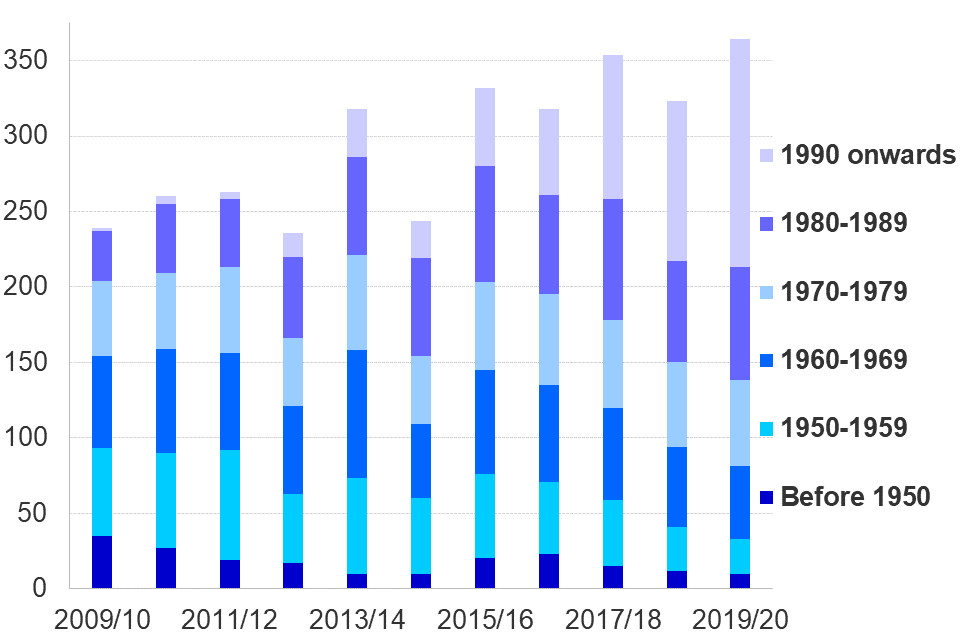
6. Special Educational Needs and Disability (SEND)
Increase in registered SEN appeals, up 13% when compared to 2018/19
In the academic year 2019/20 HMCTS tribunals recorded 7,900 registered appeals in relation to SEN, an increase of 13% when compared to the prior year. In the same period, 6,700 SEN appeals were disposed of, an increase of 14% on 2018/19.
The increase in appeals registered is likely a continued effect of the 2014 SEN reforms which introduced Education Health and Care plans (EHC) and extended the provision of support from birth to 25 years of age and the effect of the National Trial which began in April 2018. Under the National Trial the Tribunal is able to make non-binding recommendations on the health and social care elements of the EHC plan.
Figure 6.1: Registered SEND appeals, 1994/95 to 2019/20 academic years (Source: Tables SEND_1 and S_4)

SEND reforms, which came into effect from 1 September 2014, introduced Education Health and Care (EHC) plans and extended provision of support from birth to 25 years of age for those in education (excluding Higher education).
Of the 7,900 registered SEND appeals in 2019/20, 29% were against ‘refusal to secure an EHC assessment’, while over half (58%) were in relation to the content of EHC plans. The most common type of educational need identified in appeals continues to be Autistic Spectrum Disorder, accounting for 47% (3,700) of all SEN appeals.
SEND caseload outstanding reached a new high of 3,300 cases in Q2 2020/21, driven by the previously-noted rising trend in SEND appeals registered.
In 2019/20, ethnicity data was ‘not completed’ for any of the appeals registered, therefore it is not possible to provide analysis of SEN appeals by child ethnicity. As the table on ethnic origin (SEND_4) provides no new information, it will be removed from future publications until this data is populated.
In 2019/20, HMCTS recorded 6,700 outcomes in relation to SEN appeals, an increase of 14% compared to 2018/19. Of these outcomes, 56% (3,800) of cases were decided by the tribunal, an increase of 12 percentage points on 2018/19. Of the cases decided, 95% (3,600) were in favour of the appellant, an increase of two percentage points on 2018/19.
In 2019/20, there were 180 registered appeals in relation to disability discrimination, three more than the previous year (2% rise). Of these appeals, 11 cases (6%) were related to permanent exclusion from school, two cases (1%) were related to temporary exclusion, and the remainder were uncategorised.
The SEND tribunals disposed of 140 Disability Discrimination claims in 2019/20, up from 130 in the previous year (6% rise). Of these disposals, 93 claims (68%) were decided at hearing, 41 appeals (30%) were withdrawn prior to the hearing taking place, and the remaining two appeals (1%) were conceded. Of those decided at hearing, 53% were dismissed and 47% upheld – compared to 50% in 2018/19.
7. Further information
Rounding convention
Figures greater than 10,000 are rounded to the nearest 1,000, those between 1,000 and 10,000 are rounded to the nearest 100 and those between 100 to 1,000 are rounded to the nearest 10. Less than 100 are given as the actual number.
Accompanying files
As well as this bulletin, the following products are published as part of this release:
-
A supporting document providing further information on how the data is collected and processed, as well as information on the revisions policy and legislation relevant to trends and background on the functioning of the tribunal system.
-
The quality statement published with this guide sets out our policies for producing quality statistical outputs for the information we provide to maintain our users’ understanding and trust.
-
A set of overview tables, covering each section of this bulletin, an annual set of tables covering further breakdown of Special Educational Needs and Disability statistics for the Academic Year 2019/20 and two additional sets of tables on Employment Tribunals (for ET Fee Refunds and ET Management information – Annex C).
-
A set of CSV files including data on two of the three large tribunals (Employment and Immigration and Asylum) and an overall receipts and disposals CSV, covering all tribunal types.
-
Additional releases this quarter:
- Update to the statistical notice on Immigration and Asylum (I&A) Detained Immigration Appeals (DIA) to include data to Q2 2020/21.
Future publications
Our statisticians regularly review the content of publications. Development of new and improved statistical outputs is usually dependent on reallocating existing resources. As part of our continual review and prioritisation, we welcome user feedback on existing outputs including content, breadth, frequency and methodology. Please send any comments you have on this publication including suggestions for further developments or reductions in content.
Contact
Press enquiries should be directed to the Ministry of Justice or HMCTS press office:
Daniel Mulloy - email: Daniel.Mulloy@Justice.gov.uk
Other enquiries and feedback on these statistics should be directed to the Justice Statistics Analytical Services division of the Ministry of Justice:
Carly Gray - email: CAJS@justice.gov.uk
Next update: 11 March 2021 (URL: www.gov.uk/government/collections/tribunals-statistics)
© Crown copyright Produced by the Ministry of Justice
For any feedback on the layout or content of this publication or requests for alternative formats, please contact CAJS@justice.gov.uk
-
The Q3 2014/15 disposals data point is not included for disposals, in order to aid comparability. This figure was a disproportionately high outlier (index: 24.2) due to the disposal of a large multiple claim against an airline. ↩
-
Advisory, Conciliation and Arbitration Service (ACAS) ↩
-
Note that refund payments may relate to applications made in previous quarters. ↩
-
More information on the scheme is available here https://www.gov.uk/government/news/opening-stage-of-employment-tribunal-fee-refund-scheme-launched ↩
-
This figure has been revised, but remains provisional, from last quarter’s publication following a review of the process for recording interim certificates and their conversion to full certificates. ↩
-
The marital status figures will be updated in a future publication once the status is known for all applicants. ↩
